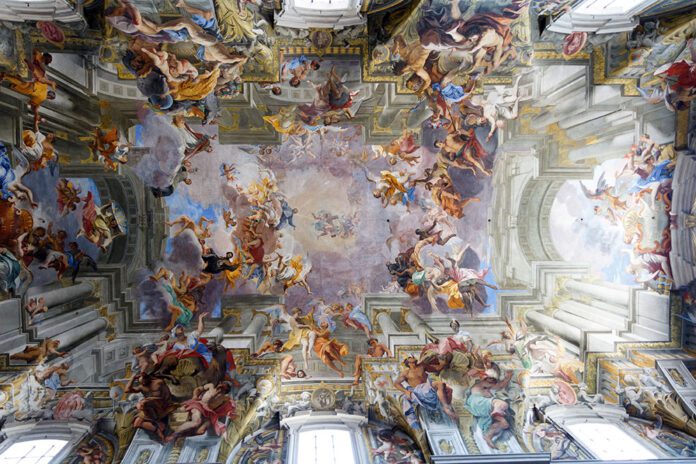I came across a poem when I was young by the Irish poet, Joseph Mary Plunkett, called “I See His Blood upon the Rose.” The poem reads:
I see his blood upon the rose
And in the stars the glory of his eyes,
His body gleams amid eternal snows,
His tears fall from the skies.
I see his face in every flower;
The thunder and the singing of the birds
Are but his voice–and carven by his power
Rocks are his written words.
All pathways by his feet are worn,
His strong heart stirs the ever-beating sea,
His crown of thorns is twined with every thorn,
His cross is every tree.
It’s a fairly simple poem in terms of its form and prosody, and the language used in the poem didn’t exceed my 12-year-old vocabulary. In fact, it was the simplicity of the poem and its repeated use of simple, concrete images from nature that made the poem stick in my memory and resurface periodically when I noticed a particularly beautiful rose or thorny bush. Although I didn’t realize it at the time, this poem played an important role in forming my imagination to be one that saw Christ in the created world–one that was Catholic, or, more specifically, sacramental.
If the imagination is understood very loosely to be a process of discovering likenesses and forming links between things, then it is critical in forming a link between external realities and the interior self. It is this process that gives meaning to the world and allows us to interpret what we observe in the world around us by discovering the otherwise invisible connections between things. Without a well-formed imagination, our lives will lack both cohesiveness and meaning. Therefore, it is very important that we not neglect our imaginations, but rather train them to notice these invisible likenesses that exist between realities.
The sacramental imagination is a specific kind of imagination that forms links between realities which are visible and realities which are invisible. To apply sacramental theology to the imagination means to consider how our imaginations can relate visible—or at least imaginable—realities and images to those realities that are unimaginable apart from divine revelation: mysteries. Sacraments, as defined by the Catechism of the Catholic Church, are “efficacious signs of grace, instituted by Christ and entrusted to the Church, by which divine life is dispensed to us.” What is unique about a sacrament is that it is a visible sign which signifies an invisible reality—grace and participation in divine life—but also which makes present and contains that which it signifies. As an “efficacious sign,” a sacrament not only signifies and gestures towards this invisible reality, but it also makes the reality present by conferring grace upon the one receiving the sacrament. Having a sacramental imagination makes what is mysterious present to us in language or art or some other form of beauty.
With so many profane and unholy images present everywhere in the world today, it’s all the more important that we actively train our imaginations to be sacramental. The best way to do this is to fill up the storehouses of our memories with sacred, holy images that make divine mysteries present to us and that can combat the profane images which plague our world and our imaginations. This tactic of using our memories to train our imaginations dates back to medieval times, when the memory was viewed as a store-room or dovecote, made up of different compartments from which particular doves can come and go as needed. This view of memory is concerned not just with retaining information, but also connecting and associating different particular truths with one another at different times. As a way of recalling and connecting truths, the medieval understanding of memory was also closely tied to a person’s holiness and moral formation, since in order to become holy, a person needed to fill up their memory with holy things.
Poetry is one medium through which you can fill up your memory with holy images. The poem, “I See His Blood upon the Rose” did this for me, as it provided simple, common images of beauty in the created world that I could link to the invisible, mysterious reality of Christ’s Incarnation. It has helped make the reality of the Incarnation and Christ’s presence in the created world more present to me every day. Another poet who does this beautifully is Gerard Manley Hopkins, a priest and poet who saw it as part of his vocation to make the mysteries of God present in his poems. There are numerous other Catholic poets and writers–like Flannery O’Connor, J.R.R. Tolkein, Evelyn Waugh, and Sigrid Undset, to name a few–who also fulfilled this vocation through their poetry and prose.
Sacred art is another medium through which we can fill up our memories and train our imaginations to be sacramental. Filling our homes with holy images and sacred art not only makes our homes more beautiful, but also makes the beautiful mysteries they depict present to us daily. Flooding our imaginations with these holy images will also help protect our imaginations against the profane images that might involuntarily present themselves.
It’s easy to remember the importance of training our intellects and our wills if we want to become holy, but it’s perhaps less obvious that our imaginations need to be trained as well, especially since our imaginations are particularly under attack in today’s world. Finding Catholic writers and reading their works, filling our homes with sacred art, or simply visiting beautiful churches or shrines are some of the ways in which we can do this. Then, our memories will be filled with holy images and we will find that there are links everywhere in the world around us to the mysteries of our Faith and to God.






